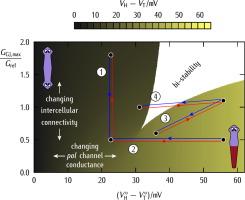当前位置:
X-MOL 学术
›
Bioelectrochemistry
›
论文详情
Our official English website, www.x-mol.net, welcomes your
feedback! (Note: you will need to create a separate account there.)
Bioelectrical model of head-tail patterning based on cell ion channels and intercellular gap junctions.
Bioelectrochemistry ( IF 4.8 ) Pub Date : 2019-11-29 , DOI: 10.1016/j.bioelechem.2019.107410 Javier Cervera 1 , Salvador Meseguer 2 , Michael Levin 3 , Salvador Mafe 1
Bioelectrochemistry ( IF 4.8 ) Pub Date : 2019-11-29 , DOI: 10.1016/j.bioelechem.2019.107410 Javier Cervera 1 , Salvador Meseguer 2 , Michael Levin 3 , Salvador Mafe 1
Affiliation

|
Robust control of anterior-posterior axial patterning during regeneration is mediated by bioelectric signaling. However, a number of systems-level properties of bioelectrochemical circuits, including stochastic outcomes such as seen in permanently de-stabilized "cryptic" flatworms, are not completely understood. We present a bioelectrical model for head-tail patterning that combines single-cell characteristics such as membrane ion channels with multicellular community effects via voltage-gated gap junctions. It complements the biochemically-focused models by describing the effects of intercellular electrochemical coupling, cutting plane, and gap junction blocking of the multicellular ensemble. We provide qualitative insights into recent experiments concerning planarian anterior/posterior polarity by showing that: (i) bioelectrical signals can help separated cell domains to know their relative position after injury and contribute to the transitions between the abnormal double-head state and the normal head-tail state; (ii) the bioelectrical phase-space of the system shows a bi-stability region that can be interpreted as the cryptic system state; and (iii) context-dependent responses are obtained depending on the cutting plane position, the initial bioelectrical state of the multicellular system, and the intercellular connectivity. The model reveals how simple bioelectric circuits can exhibit complex tissue-level patterning and suggests strategies for regenerative control in vivo and in synthetic biology contexts.
中文翻译:

基于细胞离子通道和细胞间间隙连接的头尾图案生物电模型。
生物电信号介导再生过程中前后轴向图案的鲁棒控制。但是,还没有完全理解生物电化学电路的许多系统级特性,包括诸如在永久不稳定的“隐秘”扁虫中看到的随机结果。我们提出了一种用于头尾图案的生物电模型,该模型结合了单细胞特征,例如膜离子通道和通过电压门控间隙连接的多细胞群落效应。通过描述细胞间电化学偶联,切割平面和多细胞集合体的间隙连接阻断的作用,它补充了以生物化学为重点的模型。通过显示以下内容,我们提供了有关涡形前/后极性的最新实验的定性见解:(i)生物电信号可以帮助分离的细胞结构域了解损伤后的相对位置,并有助于异常双头状态与正常头尾状态之间的转换;(ii)系统的生物电相空间显示了一个双稳定性区域,可以解释为隐性系统状态;(iii)根据切割平面位置,多细胞系统的初始生物电状态和细胞间的连通性获得与情境有关的反应。该模型揭示了简单的生物电路如何表现出复杂的组织水平模式,并提出了在体内和合成生物学环境中进行再生控制的策略。
更新日期:2019-11-30
中文翻译:

基于细胞离子通道和细胞间间隙连接的头尾图案生物电模型。
生物电信号介导再生过程中前后轴向图案的鲁棒控制。但是,还没有完全理解生物电化学电路的许多系统级特性,包括诸如在永久不稳定的“隐秘”扁虫中看到的随机结果。我们提出了一种用于头尾图案的生物电模型,该模型结合了单细胞特征,例如膜离子通道和通过电压门控间隙连接的多细胞群落效应。通过描述细胞间电化学偶联,切割平面和多细胞集合体的间隙连接阻断的作用,它补充了以生物化学为重点的模型。通过显示以下内容,我们提供了有关涡形前/后极性的最新实验的定性见解:(i)生物电信号可以帮助分离的细胞结构域了解损伤后的相对位置,并有助于异常双头状态与正常头尾状态之间的转换;(ii)系统的生物电相空间显示了一个双稳定性区域,可以解释为隐性系统状态;(iii)根据切割平面位置,多细胞系统的初始生物电状态和细胞间的连通性获得与情境有关的反应。该模型揭示了简单的生物电路如何表现出复杂的组织水平模式,并提出了在体内和合成生物学环境中进行再生控制的策略。











































 京公网安备 11010802027423号
京公网安备 11010802027423号